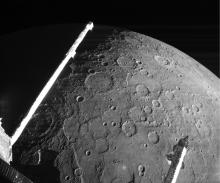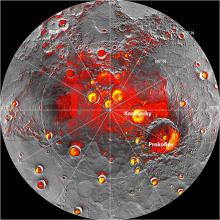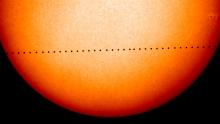Listen to today's episode of StarDate on the web the same day it airs in high-quality streaming audio without any extra ads or announcements. Choose a $8 one-month pass, or listen every day for a year for just $30.
You are here
Morning Mercury
The little planet Mercury just peeks into view in the dawn sky over the next couple of weeks. It’s hard to find, though, especially from more northerly latitudes.
Mercury is the smallest major planet in the solar system. It’s also the closest to the Sun. And it has the largest core in relation to its size — the core of iron and nickel makes up about two-thirds of Mercury’s diameter.
Earth and the other inner planets have much thicker layers around their cores. Since Mercury formed at the same time, from the same raw ingredients, that suggests it originally had thicker outer layers, too. If so, then something must have stripped much of those layers away.
One possibility is that the young Mercury was hit by another large object. The impact blasted much of the material in the planet’s outer layers into space. The same thing probably happened to the young Earth, with much of the expelled material forming the Moon.
But it’s also possible that Mercury never grabbed enough material to form thick outer layers — it’s always been about the same size it is now. Observations by a Mercury-orbiting spacecraft seem to support this idea, although they couldn’t confirm it.
Whatever Mercury was like in the beginning, you can see it now in the eastern sky in the early morning twilight. It looks like a fairly bright star. It’s quite low, though, so you need a clear horizon to spot it. The planet stands a little higher as seen from more southerly latitudes.
Script by Damond Benningfield





